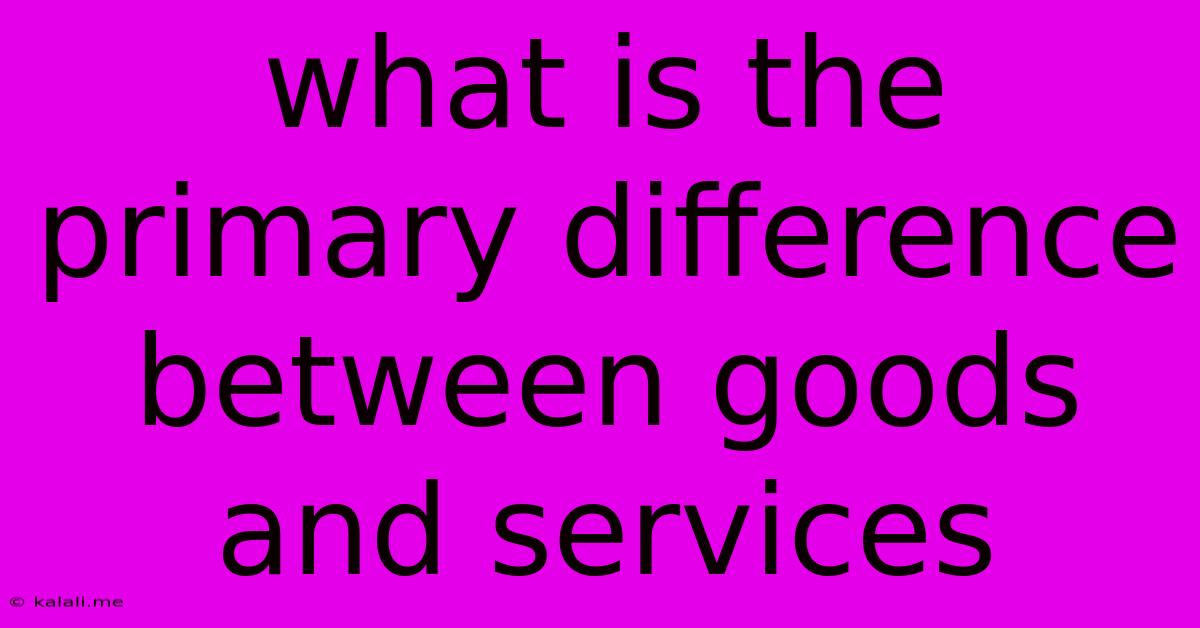What Is The Primary Difference Between Goods And Services
Kalali
Jun 15, 2025 · 3 min read

Table of Contents
What's the Primary Difference Between Goods and Services? A Deep Dive
Understanding the core distinction between goods and services is crucial for anyone involved in business, marketing, or economics. While both are offered to satisfy customer needs and wants, their fundamental characteristics differ significantly, impacting production, consumption, and marketing strategies. This article delves into the primary differences, exploring the nuances of tangibility, perishability, and other key aspects.
Meta Description: This article clearly explains the primary differences between goods and services, focusing on tangibility, perishability, and other key characteristics that impact businesses and consumers. Learn how these differences affect production, marketing, and consumption strategies.
The most fundamental difference lies in their tangibility. Goods are tangible; they are physical products you can see, touch, taste, smell, and own. A car, a book, a smartphone – these are all examples of goods. They can be stored, transported, and inventoried. Services, on the other hand, are intangible. They are actions, performances, or processes. A haircut, a consultation with a doctor, or a software subscription are all examples of services. You experience the benefit, but you don't own the service itself.
Tangibility: The Defining Characteristic
This tangibility is the primary distinction. The implications are far-reaching. Because goods are tangible, they can be easily inventoried, transported, and stored. This allows for economies of scale and standardized production. Services, being intangible, cannot be easily stored or inventoried. Their production and consumption often occur simultaneously. This impacts pricing, delivery, and quality control significantly.
Perishability: A Key Differentiator
Another crucial difference is perishability. Goods, while they may deteriorate over time, generally have a longer shelf life than services. A can of soup can be stored for months, even years. However, a hotel room unsold on a particular night represents lost revenue – that service is gone forever. This perishability of services necessitates careful capacity planning and demand forecasting to minimize waste.
Other Key Differences
Beyond tangibility and perishability, several other distinctions exist:
- Homogeneity vs. Heterogeneity: Goods can often be standardized and produced homogeneously. Think of mass-produced cars or clothing. Services, however, are often heterogeneous, varying in quality and consistency depending on the provider and the customer interaction.
- Separability vs. Inseparability: The production and consumption of goods are typically separable. A car is manufactured, then sold and consumed. Services are usually inseparable; the production and consumption happen simultaneously. The service provider and the customer must interact for the service to be delivered.
- Ownership vs. Experience: Goods grant ownership to the buyer. Services offer an experience. You own the car you buy, but you don't own the haircut you receive.
Implications for Businesses
Understanding these differences is vital for businesses. Marketing strategies, pricing models, and operational processes must be tailored to the specific nature of the offering. Goods often rely on mass production and distribution networks, while services require a focus on customer service, skilled personnel, and effective communication.
For example, a company selling software (a service) will focus on customer support and ongoing updates, unlike a company selling physical computers (goods), which will prioritize efficient manufacturing and distribution.
Conclusion
The primary difference between goods and services boils down to tangibility. While seemingly simple, this distinction cascades into significant implications for production, marketing, pricing, and consumption. Understanding this fundamental difference is essential for navigating the complexities of modern business and marketing. Businesses that effectively address the unique challenges presented by each category are better positioned for success.
Latest Posts
Latest Posts
-
The Light Year Is A Unit Of
Jun 15, 2025
-
What Is The Least Common Multiple Of 12 And 40
Jun 15, 2025
-
What Is The Prime Factorization Of 160
Jun 15, 2025
-
Which Reinforcement Schedule Is Most Effective
Jun 15, 2025
-
Which Word Is An Antonym Of Lament
Jun 15, 2025
Related Post
Thank you for visiting our website which covers about What Is The Primary Difference Between Goods And Services . We hope the information provided has been useful to you. Feel free to contact us if you have any questions or need further assistance. See you next time and don't miss to bookmark.